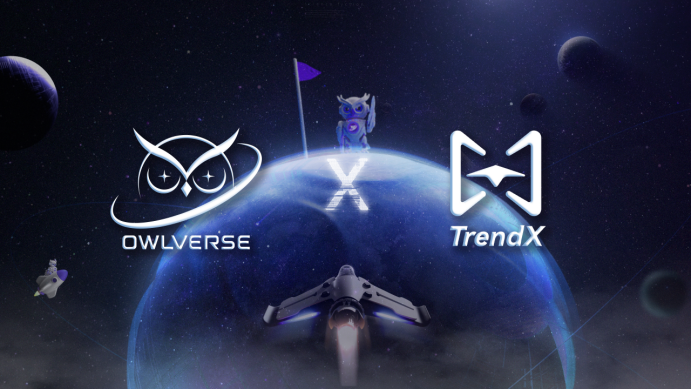2025-09-02

On August 22, 2025, the blockchain industry marked a significant milestone. The decentralized computing power network project TrendX announced the completion of its Mainnet 2.0 upgrade, officially launching a brand-new computing power scheduling system. This update is regarded as a key milestone in the DePIN (Decentralized Physical Infrastructure Network) sector and paves the way for the ecosystem expansion of its flagship product, Owlverse.
According to TrendX’s published technical documentation, the 2.0 system introduces a “layered computing structure” and a “heterogeneous task scheduling engine” at the underlying architecture level. This enables computing nodes to be allocated based on task complexity and priority to higher-value application scenarios such as AI model training, on-chain big data analysis, and real-time strategy computation.
Unlike the 1.0 phase, which mainly focused on standardized data processing, the launch of 2.0 enhances the network’s scalability and commercialization potential. Each miner’s Owlbot node is no longer just a “mining machine,” but instead evolves into a distributed computing unit capable of executing multidimensional computational tasks.
It is worth noting that starting from August 22, a limited release of 50,000 Level-1 ComputingBoxes will be made available worldwide. These ComputingBoxes serve as both the key “entry pass” for node upgrades and a scarce resource attracting market attention. On October 22, a limited release of Level-2 ComputingBoxes will follow, further advancing the layered evolution of the computing power network.
Alongside the computing power upgrade, TrendX’s Owlverse has introduced a new concept: DePinS (DePIN + SaaS).
Traditional DePIN projects—such as Grass and Filecoin—often require startup teams to build computing power networks from scratch, design economic models, and maintain communities, which sets an extremely high barrier to entry. By contrast, Owlverse’s DePinS model abstracts the underlying technology into modular SaaS services:
1. Project teams no longer need to build their own computing infrastructure; instead, they can simply leverage Owlverse-provided components.
2.All computing power and economic models are unified and driven by the $XTTA token.
3.Startup teams can focus their efforts on application innovation and community growth rather than low-level development.
In other words, DePinS is the SaaS-oriented extension of DePIN, designed to lower the entry barrier and accelerate ecosystem expansion.
Implications for the DePIN Sector
Over the past year, DePIN projects such as Grass and NodePay have attracted short-term attention, but their token prices have experienced significant volatility, making it difficult to generate long-term value. Analysts attribute this issue to fragile economic models: an overreliance on early speculative demand and a lack of sustained application support.
In contrast, Owlverse’s Vault insurance mechanism and multi-planet expansion model, combined with $XTTA token lock-up and buyback logic, are considered to provide stronger risk resistance. The multi-planet incubation plan means that 20–30 new projects are expected to join Owlverse over the next 12 months, each bringing new token demand and computing power tasks.
Industry observers believe that if DePinS is adopted by more startup teams, Owlverse could become the “infrastructure provider” for the entire sector, similar to how SaaS platforms drove the enterprise software industry during the Web2 era.
Conclusion
TrendX’s 2.0 upgrade and Owlverse’s DePinS model mark a new stage for the DePIN sector: shifting from hardware-driven operations to SaaS-enabled solutions, and from single-project narratives to multi-project symbiosis.
Although the DePinS model is still in its early exploratory phase, it is attempting to address a core question in the DePIN industry: how to enable broader participation in decentralized infrastructure development at lower cost.
Looking ahead, as the computing power network expands and application scenarios are implemented, whether Owlverse can become the new benchmark in the DePIN sector will be a key focus for industry observers.
The First Series of the World Chinese Medicine Forum in 2025 Concludes Successfully
The Second Series of the World Chinese Medicine Forum in 2025 Concludes Successfully
Tianjiang Pharmaceutical, a Subsidiary of China TCM, and Singapore College of Traditional Chinese Medicine Sign Strategic Cooperation Framework Agreement on TCM Education and Exchange
Tianjiang Pharmaceutical, a Subsidiary of China TCM, Participates in the 4th CACM Specialized Disease Collaboration Platform Annual Conference & 10th Jiangsu Traditional Chinese Medicine Academic Conference
Tianjiang Pharmaceutical, a Subsidiary of China TCM, and Federation of Chinese Medicine & Acupuncture Societies of Australia Sign Strategic Cooperation Framework Agreement
MEXC Claims Dual Wins at BeInCrypto 100 Awards as Best Centralized Exchange and Best Exchange in LATAM
©copyright 2009-2020 Singapore Info Map